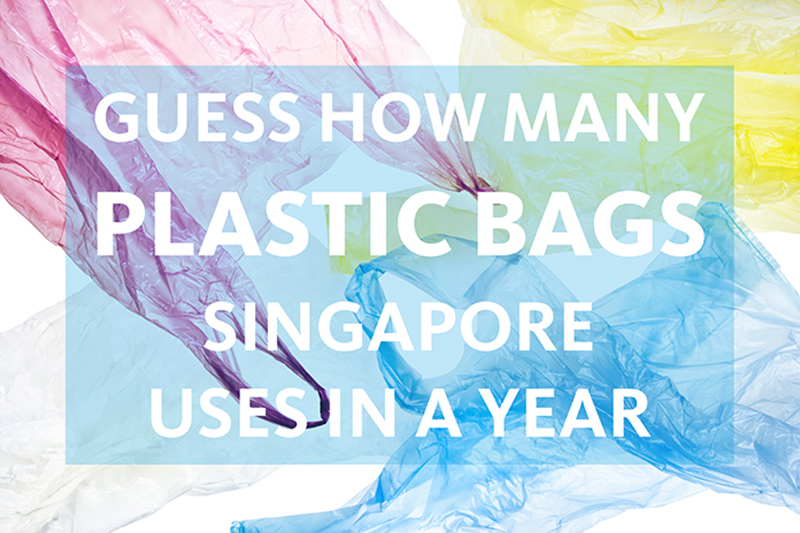Guess how many plastic bags Singapore uses in a year. 500 million? 800 million?
According to a study released by the Singapore Environment Council in 2013, Singapore uses about 3 billion plastic bags a year. That’s astounding by any standard.
Why are we talking about plastic bags, you ask? Look around. We use a lot of them! Triple-bagged items at the grocery store, a big bag for carrying smaller bags, and even a plastic bag carrier for takeaway coffee. We need change.
In fact, even if we stopped using plastic bags tomorrow, many environmentalists and academics believe that we’re near or past the point of irreversible climate change.
Last month, 187 countries and territories participated in the largest Earth Hour to date. More than 3,100 landmarks and monuments – including the Statue of Liberty, Eiffel Tower, Big Ben, and Leaning Tower of Pisa – and countless individuals switched off their lights for an hour in a symbolic gesture toward promoting climate change.
At SMS | CURVATURE, besides carrying out our endless crusade to help our clients save costs and develop an IT asset management strategy for end-of-life planning, our work promotes green IT practices that are not just financially beneficial, but also environmentally friendly.
Why are we green?
In conjunction with the U.S. Department of Energy, researchers at Stanford, Northwestern, and Carnegie Mellon universities found that U.S. data centers consumed about 70 billion kilowatt hours in 2014, representing two percent of the country’s total energy consumption.
As consumers increasingly rely on digital services to power their lifestyles, corporations race to better understand, predict, and serve these needs. The reality is that even as data centers become more power-efficient, energy consumption has continued to rise. The 2014 U.S. Department of Energy report also predicted a four percent growth rate through 2020.
Although data centers are not a main contributor to climate change, our modern lifestyles are heavily reliant on things like data centers, fossil fuels, plastic bags and disposable containers, the sum of which can have harrowing effects on the planet.
I’ve previously written about how marketers are bombarding us with fear, uncertainty, and doubt, but climate change is not marketing hype. Here are some facts to think about:
- Melting ice caps: Since the 1950s, scientists have been studying and speculating on the effects of global warming. Roger Revelle, one of the early scientists who pioneered studies on global warming, warned that rising temperatures might melt the Greenland and Antarctic ice caps, thus raising sea levels. It seemed like science fiction then, but it’s happening today.
- Atmospheric carbon dioxide: In 2015, the global concentration of carbon in the atmosphere stood at approximately 398.55 parts per million. By September 2016, atmospheric carbon dioxide reached a new high, passing the 400 ppm threshold. And it’s unlikely to dip below 400 ppm again for at least another generation.
- Shrinking coastlines: According to the Intergovernmental Panel on Climate Change, global sea levels have risen 20 cm (just under eight inches) since 1870. Inevitably, sea-level rise will alter landscapes around the world, forcing coastal inhabitants to move inland for safety. It’s suggested that the rising sea levels will eventually swallow whole islands.
While some organizations have made strides in building green data centers, many others have not had such ambitious goals in mind.
At SMS | CURVATURE, we have a strategy for green tech. We ensure the quality, transparency, and environmental and social responsibility of every piece of equipment we ship. And we’re not just saying that; last year, our operations in Santa Barbara became certified to the R2:2013 Standard, the electronics recycling industry’s leading certification.
Where do we begin?
According to a McKinsey study from 2014, more CEOs are prioritizing sustainability than ever. The real challenge, however, is managing short-term earnings pressures that are at odds with the longer-term goals of sustainability.
Being green doesn’t just start with your next purchase or how you design your data center. Those aspects are important, but equally vital is understanding the impact of the components you currently own and use.
How many unused pieces of computer gear are still running in your office or server room? One of the things we do at SMS | CURVATURE is simplify these questions for clients. We help clients develop an IT asset management strategy for end-of-life planning for remarketing, and also ensure they do not just leave old or surplus equipment to collect dust in storage, as many organizations do, but to recoup value by selling them to us.
In 2013, Curvature shipped more than half a million pre-owned items. As a result, we’ve saved over 3.6 million pounds of potential e-waste from landfills. That’s approximately 1,820 tons – or, in other words, nearly 3,150 dump trucks lined up for almost eight miles.
It’s something we’re really proud of, but it’s also a goal that keeps getting loftier with each passing year. Stewarding sustainability is a complex effort. There are many facets to such programs, and there’s much to consider.
If you can be sustainable with what you already own, you not only yield immediate returns, but also slow the effects of climate change.
And remember to bring your own bag to the grocery store.



